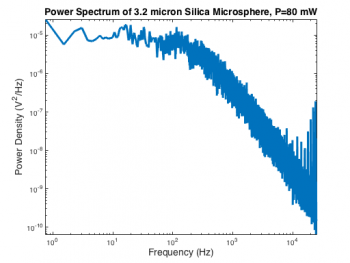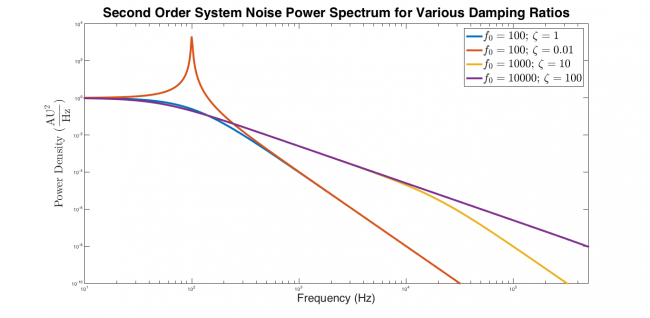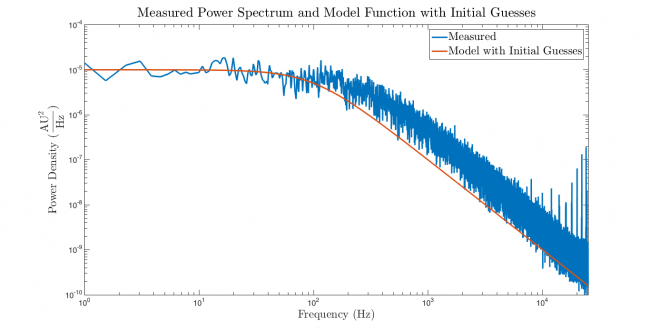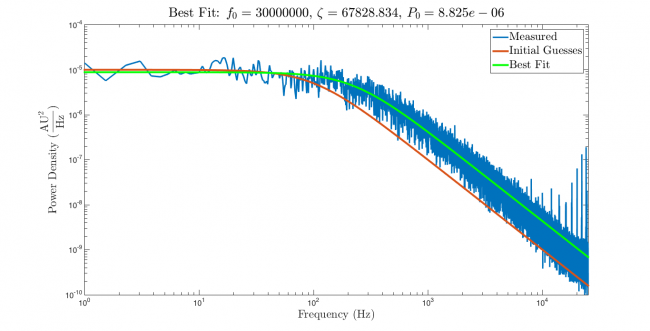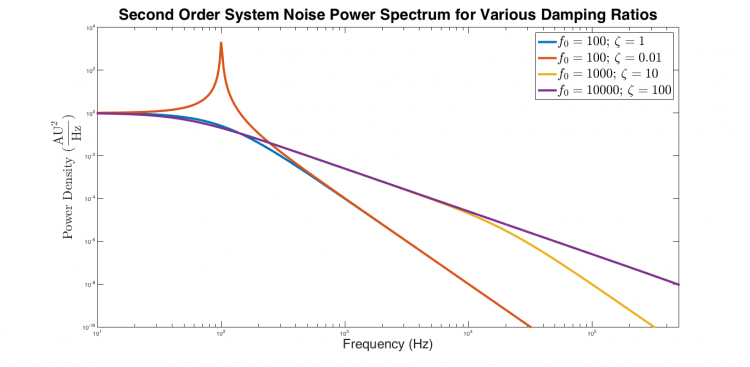Difference between revisions of "Estimating second order system parameters from noise power spectra using nonlinear regression"
(→Go ... first attempt) |
(→Assessing the regression results 1: examine the residuals) |
||
| Line 156: | Line 156: | ||
==Assessing the regression results 1: examine the residuals== | ==Assessing the regression results 1: examine the residuals== | ||
| − | With some effort, It's possible to decode the warning messages generated by the previous regression. ([http://stats.stackexchange.com/questions/35071/what-is-rank-deficiency-and-how-to-deal-with-it This page] has a good discussion of rank deficiency.) But even if you understand the warnings perfectly, there | + | With some effort, It's possible to decode the warning messages generated by the previous regression. ([http://stats.stackexchange.com/questions/35071/what-is-rank-deficiency-and-how-to-deal-with-it This page] has a good discussion of rank deficiency.) But even if you understand the warnings perfectly, there is still a long list of root problems might have lead to either of them. <tt>nlinfit</tt> can tell that there were some concerning symptoms, but it doesn't have the ability to suss things out. So it either avoids the issue (as in the first warning) or it produces a laundry list of possibilities (as in the second warning). This is probably why <tt>nlinfit</tt> and the Mystic Seer seem to have so much in common. |
| − | + | Instead of trying to decipher the warning messages, it's frequently more productive to revisit the construction of the regression. Violations of the regression assumptions are a leading cause of trouble. One of the most fundamental assumptions in the regression model is that the error terms are independent and identically distributed. An easy way to gauge the validity of this assumption is to plot the vector of residuals versus the independent variable and have a look. (The second value returned from <tt>nlinfit</tt> contains a vector of the residuals.) If the regression assumptions are perfectly met, the plot should look something like the plot on the left below. The plot below on the right shows the actual residuals from this regression. | |
<center> | <center> | ||
| Line 166: | Line 166: | ||
</center> | </center> | ||
| − | + | Holey moley! The right plot does not look at all like the left one. The magnitude of the residuals decreases dramatically as frequency increases — a significant and unacceptable violation of the regression assumptions. We definitely have a bad regression on our hands. | |
This has to be fixed before moving on. | This has to be fixed before moving on. | ||
Revision as of 14:55, 2 June 2015
… the safe use of regression requires a good deal of thought and a good dose of skepticism
If your program generates an error message rather than curve fitting results, you probably won’t be able to make sense of the exact wording of the message.
—Motulsky and Shristopoulos. Fitting Models to Biological Data using Linear and Nonlinear Regression
You won't find a tool with more power per inch than a chain saw. Power like that requires extra attention to safety.
—lowes.com
Overview
In the limits of detection lab, you will use nonlinear regression to estimate the parameters of second order system models of the optical trap and atomic force microscope (AFM). Nonlinear regression has a lot in common with chainsaws. In skilled hands, both chainsaws and powerful regression functions like MATLAB's nlinfit can deliver sublime results[1]. But great power comes with great danger. Like all sharp power tools, nlinfit and chainsaws must be used with extraordinary care. Inattentive or unskilled operation engenders distorted, ugly, or even catastrophic[2] outcomes.
An important difference between chainsaws and nlinfit is that chainsaw accidents are graphic and obvious whereas many mortal regression wounds are stealthy. Bad regressions can easily masquerade as good ones — concealing their insidious flaws behind an alluring, plausible pair of overlapping curves. Because of this, it especially important to maintain a critical and alert mindset in the vicinity of regression. After every regression, do the responsible thing: spend some time ascertaining how disgraceful the sin you just committed was.
This page offers some advice that will help you retain all of your digits and limbs as you regress power spectra from the AFM and optical trap. Several flawed regressions are illustrated, followed by possible fixes. This sort of thing frequently happens: it takes a few tries to get the kinks out of a regression. Along the way, there are many signs of possible problems, but no definitive indicators of success. It can be difficult to tell when it's safe to stop.
Regression concepts review
Nonlinear regression is a method for finding the relationship between a dependent variable $ y_n $ and an independent variable $ x_n $. The two quantities are related by a model function $ f(\beta, x_n) $. $ \beta $ is a vector of model parameters. The dependent variable $ y_n $ is measured in the presence of random noise, which is represented mathematically by a random variable $ \epsilon_n $. In equation form:
- $ y_n=f(\beta, x_n)+\epsilon_n $.
The goal of regression is to determine a set of best-fit model parameters $ \hat{\beta} $ that match the observed data as closely as possible. Because the dependent variable includes noise, $ \hat{\beta} $ will not be equal to $ \beta $. As you can probably guess, decreasing the noise or increasing the number of observations tends to make the difference between $ \hat{\beta} $ and $ \beta $ smaller.
Ordinary nonlinear least squares regression assumes that:
- the independent variable is known exactly, with zero noise,
- the error values are independent and identically distributed,
- the distribution of the error terms has a mean value of zero,
- the independent variable covers a range adequate to define all the model parameters, and
- the model function exactly relates $ x $ and $ y $.
These assumptions are almost never perfectly met in practice. It is important to consider how badly the regression assumptions have been violated when assessing results.
Get ready …
You need four things to run a regression:
- a vector containing the values of the independent variable;
- a vector containing the corresponding observed values of the dependent variable;
- a model function; and
- a vector of initial guesses for the model parameters.
Independent variable and observations
The second order system model of the optical trap makes predictions about the power spectrum of a thermally excited, trapped microsphere, whereas the instrument actually records a time sequence of voltages from the QPD position detector. The raw data must be converted into a power spectrum before fitting.
MATLAB has a function called pwelch that computes a power spectrum $ P_{xx}(f) $ and associated frequency bin vector $ f $ from a time series. Like many MATLAB functions, there are several different ways to invoke pwelch. Even judging by Mathworks' low standards for clarity and consistency, the various forms of pwelch are perplexing. Here is the command that generated the spectrum on the right:
[ Pxx, frequency ] = pwelch( OpticalTrapTimeDataX, [], [], [], 50000 );
The first argument, OpticalTrapTimeDataX is an Nx1 vector containing the QPD x-axis voltage samples. Empty values for the next three parameters (window, noverlap, and f) leave them set to their default values. The last argument is the sampling frequency, $ f_s $. We will reexamine the default parameter settings later on.
The two quantities in the regression are frequency and power spectral density. One of these has to serve as the independent variable, and the other as dependent. In order to make the best choice, it is necessary to consider the relative influence of measurement noise. The optical trap has a very accurate and precise oscillator circuit that generates its sample clock. Because the sample frequency is so stable, measurement error in the frequency values calculated by pwelch is tiny. Power spectral density, on the other hand, is inherently noisy due to the random nature of the thermal driving force. You can see how wiggly the power spectrum is in the vertical direction. So the choice of independent and dependent variables is easy: the low-noise quantity, frequency, will serve as the independent variable and the noisy quantity, power spectral density, will be the dependent variable.
Model function
nlinfit requires that the regression model be expressed as a function that takes two arguments and returns a single vector of predicted values. The signature of the model function must must have the form:
[ PredictedValues ] = ModelFunction( Beta, X ).
The first argument is a vector of model parameters. The second argument is a vector of independent variable values. The return value must must have the same size as the second argument.
The MATLAB function defined below models the power spectrum of a second-order system excited by white noise. The three model parameters are passed to the function in a 1x3 vector: undamped natural frequency $ f_0 $, damping ratio $ \zeta $, and low-frequency power density $ P_0 $.
function [ PowerDensity ] = SecondOrderSystemPowerSpectrum( ModelParameters, Frequency )
undampedNaturalFrequency = 2 * pi * ModelParameters(1);
dampingRatio = ModelParameters(2);
lowFrequencyPowerDensity = ModelParameters(3);
s = 2i * pi * Frequency;
response = lowFrequencyPowerDensity * undampedNaturalFrequency.^2 ./ ...
( s.^2 + 2 * undampedNaturalFrequency * dampingRatio * s + undampedNaturalFrequency.^2 );
PowerDensity = abs( response ).^2;
end
It's a good idea to test the model function out before you use it. The plot below shows four sets of curves generated by SecondOrderSystemPowerSpectrum. The critically damped response is flat from low frequency until approximately $ f_0 $, after which it falls with a slope of -4. The underdamped response exhibits a narrow peak near $ f_0 $ and then decreases with slope -4 at high frequencies. Both overdamped systems are flat at low frequencies. They decrease with slope -2 at intermediate frequencies from approximately $ \frac{f_0}{\zeta} $ to $ f_0 $, after which the response falls with slope -4. It's comforting to see that the curves have the expected shape.
Initial guesses
There are three model parameters, so three initial guesses are required. nlinfit infers the number of model parameters from the size of the Initial guess vector. Accordingly, the initial guesses should be stored in a 1x3 vector. You can eyeball a reasonable starting point by taking a look at the PSD plot, say: 500 Hz for $ f_0 $, 10-5 AU2/Hz for $ P_0 $, and 1 for the damping ratio.
Get set …
The first step of all regressions is to plot the observations and the model function evaluated with the initial guesses versus the independent variable on a single set of axes. Don't attempt to run nlinfit until you've done this plot. It is much easier to ensure that the arguments to nlinfit are in order before you regress than to debug a screen full of cryptic, red text after. Side effects of premature regression include confusion, waste of time, fatigue, irritability, alopecia, and feelings of frustration. There is no chance that nlinfit will succeed if there is a problem with one of its arguments.
Go ahead ... do the plot.
Now we can proceed with confidence that the arguments to nlinfit are plausible.
Go ... first attempt
The plot below shows the results of running regression with the data, model, and initial guesses developed so far. The green line on the plot shows the model function evaluated with best-fit parameters $ \hat{\beta} $. The best-fit model nicely overlaps the measured data.
Success! Great curves!
Not so fast. If you let the alluring, overlapping blue and green curves in the plot above get you excited, go back and reread this page from the beginning. Much more scrutiny is required. On top of the usual reasons to be skeptical, an additional cause for concern materialized in the console output window. MATLAB barfed up a long, impenetrable, word salad of foreboding red verbiage. Running the regression triggered two different warnings.
The first warning repeated itself about a dozen times, each time with a slightly different value of "tol":
Warning: Rank deficient, rank = 2, tol = 1.099158e-10. > In nlinfit>LMfit (line 574) In nlinfit (line 276)
Then the regression finished with a second distress signal:
Warning: Some columns of the Jacobian are effectively zero at the solution, indicating that the model is insensitive to some of its parameters. That may be because those parameters are not present in the model, or otherwise do not affect the predicted values. It may also be due to numerical underflow in the model function, which can sometimes be avoided by choosing better initial parameter values, or by rescaling or recentering. Parameter estimates may be unreliable. > In nlinfit (line 373)
The first warning is terse and cryptic. The second one is spectacularly ambiguous. It's impossible to know how to react. Deep concern? Annoyance? Fear? Rage? Apathy? (It's just a warning, after all.) The parameter estimates MAY be unreliable. But then again they MAY not. A more forthright author could have written, "This regression smells fishy. Almost anything could have caused the problem. Beware."
So is this regression a good one or a bad one? Red text spewing from nlinfit is never good news. But It is sometimes not bad news. How can you tell? When it comes to error messages and warnings, nlinfit works just like the Mystic Seer that featured prominently in the unforgettable 43rd Twilight Zone episode Nick of Time starring William Shatner as a superstitious newlywed stranded in a small town with car trouble and Patricia Breslin as his beautiful and sensible bride[3]. Over-interpreting the willfully vague pronouncements of a mechanical contrivance can get you into deep trouble. The real enemy is human frailty. Or is there perhaps a greater force at play?
It's best not to spend too much time figuring it out. Get out of town while you still can.
Assessing the regression results 1: examine the residuals
With some effort, It's possible to decode the warning messages generated by the previous regression. (This page has a good discussion of rank deficiency.) But even if you understand the warnings perfectly, there is still a long list of root problems might have lead to either of them. nlinfit can tell that there were some concerning symptoms, but it doesn't have the ability to suss things out. So it either avoids the issue (as in the first warning) or it produces a laundry list of possibilities (as in the second warning). This is probably why nlinfit and the Mystic Seer seem to have so much in common.
Instead of trying to decipher the warning messages, it's frequently more productive to revisit the construction of the regression. Violations of the regression assumptions are a leading cause of trouble. One of the most fundamental assumptions in the regression model is that the error terms are independent and identically distributed. An easy way to gauge the validity of this assumption is to plot the vector of residuals versus the independent variable and have a look. (The second value returned from nlinfit contains a vector of the residuals.) If the regression assumptions are perfectly met, the plot should look something like the plot on the left below. The plot below on the right shows the actual residuals from this regression.
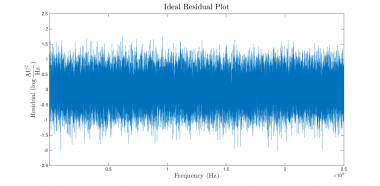 |

|
Holey moley! The right plot does not look at all like the left one. The magnitude of the residuals decreases dramatically as frequency increases — a significant and unacceptable violation of the regression assumptions. We definitely have a bad regression on our hands.
This has to be fixed before moving on.
Second attempt
The biggest issue with the first regression is that the statistics of the error terms assumed in the regression model are a terrible model for the measurement error in the PSD. In retrospect, this problem should have been obvious. A quick glance at the PSD plot reveals that the measurement error (fuzziness of the line) stays about the same size over the whole plot. But the axes are scaled logarithmically, so a certain level of fuzziness near the top of the plot represents a much larger error magnitude than the same amount of fuzziness near the bottom of the plot. The errors are nowhere identically distributed, so there wan't any hope of getting a good residual plot. It turns out that measurement error in the PSD is roughly proportional to the magnitude squared of the optical trap transfer function.
So why does the measurement error in the PSD scale that way? Handwaving alert: the following explanation is not particularly rigorous. At the most fundamental level, the problem arises because the quantities in the PSD are an attempt to estimate the mean value of a random variable from a finite samples. The model of the optical trap consists of a second-order system driven by thermal (white) noise. If you observe white noise forever, it has a perfectly flat power spectrum. But over a finite time window, the PSD of white noise is fuzzy. In a finite interval, the random signal contains a little extra power in some frequency bins and a little less power in others just due to pure chance. For obvious reasons, the optical trap's output power spectrum was not measured over an infinite time period. Since the output PSD is equal to the input PSD times the magnitude squared of the transfer function, fuzziness of the finite-interval input power spectrum gives rise to measurement error in the output PSD. Assuming the variation in the input signal's power spectrum has the same distribution at all frequencies, the measurement error in the output power spectrum is proportional to the magnitude squared of the transfer function. (If you are interested in a more mathematically precise argument, this presentation is a good starting point)
Fortunately, there are a few easy ways to fix the problem. One approach is to transform the dataset into log space[4]:
- $ \log{y_n}=\log{f(\beta,x_n)\epsilon_n}=\log{f(\beta,x_n)}+log{\epsilon_n} $
Taking the log of the dependent variable turns multiplicative noise into additive noise. The code below uses MATLAB's anonymous function syntax to create a log-space version of the model function.
logModelFunction = @( p, f ) log( SecondOrderSystemPowerSpectrum( p, f ) );
Simple enough. Now call nlinfit with logModelFunction instead of @ModelFunction. Remember to also take the log of $ P_{xx} $.
Here are the results and the new residual plot:
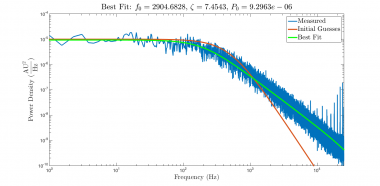 |

|
The estimate of $ f_0 $ changed by more than 250 Hz, and the residual plot is much closer to the ideal. There is a slight smile shape to the curve that indicates the presence of systematic error in the model. (The model function does not perfectly match the system — perhaps due to nonlinearity.) But the distribution of the residuals looks a great deal more like the ideal plot and the deviation from the model is small.
MATLAB's warning this time is much shorter (but not more helpful):
Warning: The Jacobian at the solution is ill-conditioned, and some model parameters may not be estimated well (they are not identifiable). Use caution in making predictions. > In nlinfit (line 376)
In general, the less red text produced by nlinfit the better. Progress.
Assessing the regression take 2: parameter confidence intervals
Range of independent variable
| Power spectra of critically damped, underdamped, and overdamped second order systems excited by white noise. The underdamped response is flat at low frequencies, exhibits a narrow peak near $ f_0 $, and decreases with slope -4 at high frequencies. The critically damped response is flat from low frequency until approximately $ f_0 $, after which it falls with a slope of -4. Both overdamped systems are flat at low frequencies. They decrease with slope -2 at intermediate frequencies from approximately $ \frac{f_0}{\zeta} $ to $ f_0 $, after which the response decreases with slope -4. |
Comparing the three regressions
- ↑ See, for example, [1] or [2]
- ↑ Do not follow this link if you are at all squeamish: [3]
- ↑ If you haven't seen this sublime 25 minutes of televised perfection, go watch it right now. I will give a 24 hour extension to anybody who writes a 1-5 page essay on the episode.
- ↑ Two other reasonable approaches to fixing the problem are: change the value of the ErrorModel parameter to nlinfit, or use the Weights option.


